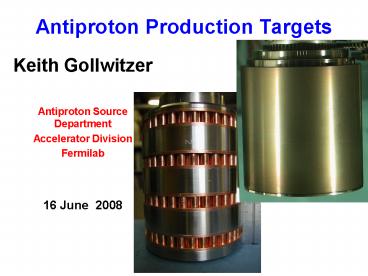Antiproton Production Targets - PowerPoint PPT Presentation
1 / 10
Title:
Antiproton Production Targets
Description:
I am not well versed in targets. The Antiproton Target Station Group of the ... Heat sink consisted of deformed copper balls brazed together and to inner copper ... – PowerPoint PPT presentation
Number of Views:49
Avg rating:3.0/5.0
Title: Antiproton Production Targets
1
Antiproton Production Targets
- Keith Gollwitzer
- Antiproton Source Department
- Accelerator Division
- Fermilab
- 16 June 2008
2
Disclaimer
- I am not well versed in targets
- The Antiproton Target Station Group of the
Mechanical Support Department of the Accelerator
Division have been working for years on the
improvements of the target, lens, collimator and
pulsed magnet - I can put you in contact with the engineers
involved with the target station
3
Style A Target Target stack consists of target
disks (nickel alloy) and copper heat sinks Air
is directed through the center of cylinder from
the top and then through the copper baffle
sections Beam goes through a chord of the target
disk Target stack is rotated 17o after each
proton pulse Entire target stack is moved
vertically to fresh target material Style has
been in use for several years
4
Style A Target This target stack was installed
Dec 27 and removed May 22 Precision beam control
needed to not target copper Heat sink and target
material separation can be seen lose cooling
effectiveness Believed missing material caused
by oxidation which leads to weakened material
that is then subject to beam Nominal spot size
200µm smaller beam size causes sputtering
which can coat the lens with unwanted heat sources
5
Style B Target No stacking of disks target
cylinder means nearly twice as much target
material Center of target cylinder still has air
flow with heat sink Heat sink consisted of
deformed copper balls brazed together and to
inner copper tube. Beryllium cover to remove
chance for oxidation as well as keeping sputtered
material contained.
6
Operational Plan
- Run normal beam until see degradation
- Run 1 week with no beam sweeping
- Run a few days with reduced spot size (with beam
sweeping) - Check visually for any problems
- Ran 1 week and saw change in air flow
- Compromised heat exchanger
- Ran additional 10 days before degradation
- Ran two days with no beam sweeping
- Saw opportunity to do last step ran less than
one day with smaller spot size
7
Operational Plan
- Run normal beam until see degradation
- Run 1 week with no beam sweeping
- Run a few days with reduced spot size (with beam
sweeping) - Check visually for any problems
- Ran 3 days and saw change in air flow
- Compromised heat exchanger
- Ran additional 2 weeks before degradation
- Ran two days with no beam sweeping
- Saw opportunity to do last step ran less than
one day with smaller spot size - Rotation problem
8
Style B Target Ran 17 days of normal beam
conditions. After 3 days heat exchanger
disappeared Can see heat band on beryllium
cover Probably developed crack after losing
cooling Note that we ran without moving target
stack for gt2X longer than Style A Target. Also
note discoloration at top probably due to
excessive heat
9
Style B Target Ran less than a day with smaller
spot size and beam sweeping Lack of target
cooling and targeting near bottom of disk caused
the beryllium cover to move and interfere with
rotation Can see shift in cover pieces Can see
where targeted for two days without sweeping Can
see evidence for sputtering at last
position Dont know if large cover separation
was before/after rotation problems
10
Status and Plans
- Believe failure of heat exchanger led to further
problems - Believe better performance with Style B Target
has been achieved - Have all material and parts for Style A Target
will assemble - Have all material for Style B Target design more
robust heat exchanger followed by assembly of
complete target - Will complete both in next few months current
Style A target should last 4-5 months































